Quiet Champion, Galen Williams
Poetic San Miguel |
|
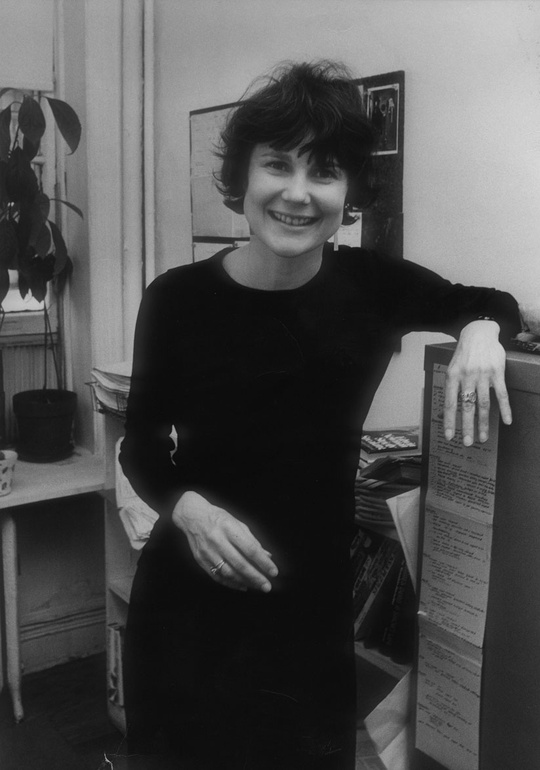
Galen Williams 1970
*
Español
July 20, 2025
by Catherine Marenghi
This article is part of a continuing series on poets and poetry with roots in San Miguel de Allende.
*
One of the most influential forces in modern poetry lives quietly in San Miguel. You won't find her on Wikipedia. She has written no memoir—although what a memoir it would be!
Search for her name on Google or ChatGPT, and you won't find much, and what you do find is often wrong. One source stated she was born in 1920 – that would make her 105 years old! Instead, she is a vibrant 87.
She is Galen Williams. And I had the privilege to meet with her recently at Café Murmullo, a short walk from her San Miguel home.
Williams is acclaimed for two famous roles: first, she was director of the legendary 92nd Street Y Poetry Center (now called the Unterberg Poetry Center) in New York City, one of the oldest and most revered reading series in the country. It has featured poets like e.e. cummings, Dylan Thomas, James Baldwin, Sylvia Plath, and countless others.
Second, she founded Poets & Writers, the prominent foundation, magazine, and resource center that continues to showcase and nurture the most influential literary voices. It is today the largest nonprofit foundation serving poets and writers.
Williams had a radical idea: She believed poets should be paid for their work! In the 1960s, poets often did readings in coffee houses for meager tips. Even the most outstanding poets received little or no compensation for their public appearances. Galen Williams was determined to change all that.
Many literary figures have credited her with creating a new professional path for poets. Today, programs like Poets & Writers' Readings & Workshops are a direct legacy of her conviction that literature needs not just stages, but funding, fair pay, and respect for the writer's craft.
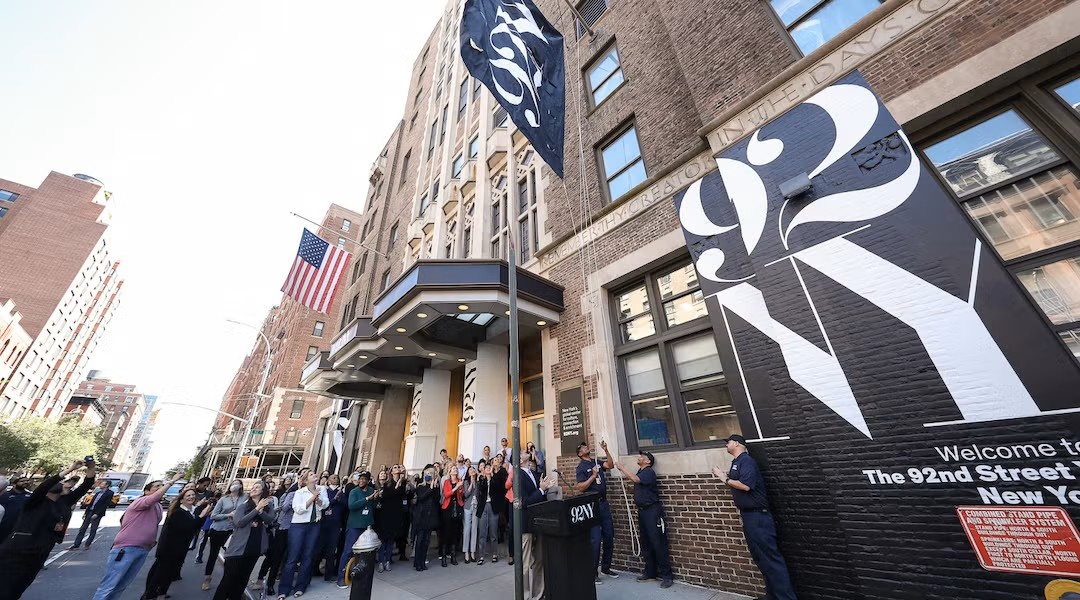
Early Life
Galen Williams spent most of her childhood on a remote 125-acre farm in Frenchtown, New Jersey, on the Delaware River. Her parents divorced when Williams was four and her brother Peter was three, and her father was awarded custody of the children – an unusual arrangement, especially in the 1940s.
"The farm had sheep, cows, horses, geese, chickens, and cats," she recalled. "We also raised pulik dogs, a Hungarian herding dog known for long, corded curls that look like dreadlocks. Because it was during the war, we also had a small vegetable garden, like a victory garden. Our house was quite remote.There was a one-room schoolhouse up a three-mile dirt road, but my father paid to send my brother and me to the public school in Frenchtown, five miles up the Delaware River."
On weekends she often took the train to New York City to visit her mother, giving her a taste of the city experience. When her father remarried, her stepmother put her on the socialite track, and Williams formally "came out" as a debutante. Between New York City and her rural home, "it was like living in two worlds," Williams said.
After graduating from eighth grade, Williams attended St. Mary’s in the Mountains, a private Episcopalian girls' school in New Hampshire. "This was ski country. I became an avid skier and made the school's ski team."
Meanwhile her father made a dramatic career shift: he sold the New Jersey farm to prospect for uranium in Colorado. Williams recalled going to visit her father in Colorado over a few summers and helping him with prospecting. Working on rough terrain, wearing heavy boots and doing her best to avoid rattlesnakes, Williams operated a machine called a scintillator – similar to a Geiger counter – to detect radiation levels and help map possible uranium sources.
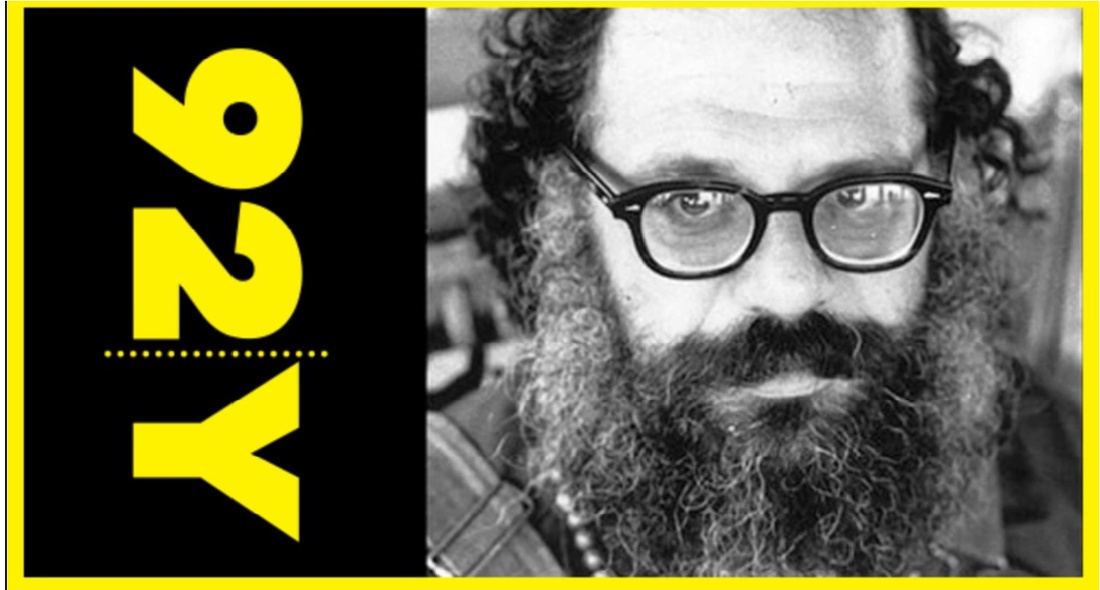
Allen Ginsberg at 92 St Y Poetry Center 1973
*
Williams moved to Boston to attend Radcliffe, where she met and married her first husband: a violinist and conductor named Carl Eberl. After their wedding, the couple moved to the Forest Hills neighborhood of Queens, New York. Williams transferred to Barnard College to complete the final two years of her college education. She majored in English. Living off campus and commuting an hour and a half to Barnard, she formed a tight bond with a small group of women who were also commuters, married or engaged to be married, and English majors; they became lifelong friends.
To fulfill her graduation requirements, Williams took a class in rhetoric. Fortuitously, it turned out to be a class in English and American poetry; her professor simply ignored the rhetoric textbook. It was her first experience with modern poetry.
In her senior year, Williams's husband applied for a Senior Fulbright grant to study music in Munich. Williams had some extra credits at Barnard, and she used them to study German. Eberl, whose family was Austrian, already spoke German. When she finished her final exams, she came home to find her husband joyfully waving a piece of paper. He got the grant, and in three days, the couple would set sail for Europe on the "Fulbright boat," the ship used by Fulbright scholars for transatlantic crossings.
The ship set sail before Barnard commencement exercises. Williams never picked up her college diploma.
Upon arriving in Germany, the couple bought a Mercedes from the factory. As there was no requirement to remain in Munich, for the next 18 months they toured all over Europe. All the while, Williams had no idea what she would do after they returned to the States.
On the ocean voyage back to the U.S., Williams was talking with some of her husband's musician friends over a game of bridge. One of them was Mel Kaplan, an oboist, who had played in concerts at the Metropolitan Museum of Art. He told Williams, "I know the hiring manager at the Met – I'll get you an introduction."
Having minored in art history at Barnard, the prospect of a job in the art world was appealing. Wasting no time, she got her appointment at the Met – just two days after returning to the States on Labor Day weekend, 1961.
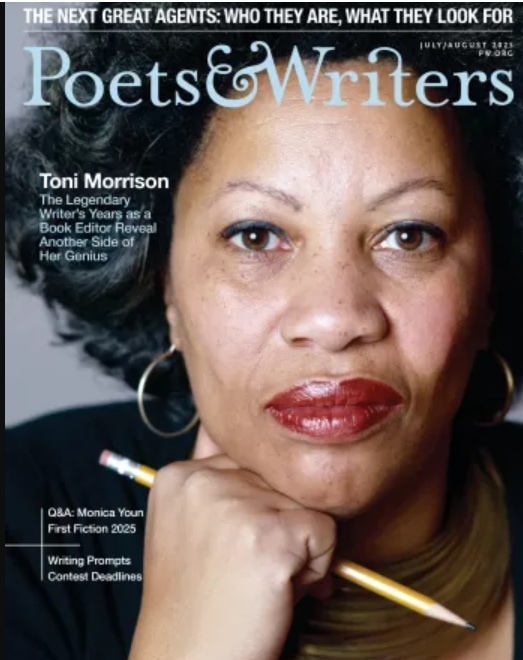
P&W cover, Toni Morrison
*
Launching a Career
Williams wears a family signet ring that bears a Latin motto: "Cognoscere occasionem." It means "Recognize the opportunity." The motto would prove prophetic.
"It's another way of saying 'seize the day.' That's what I've been doing all along," she said.
At the Metropolitan Museum, the 23-year-old Williams had the good fortune to meet with Dr. William Kolodney, who had created the music program at the Met in 1954. At the same time, Dr. Kolodney was well known for his work at the 92nd Street Y, or Young Men's and Young Women's Hebrew Association, which he joined in 1935 as Education Director. Dr. Kolodney brought a range of arts programs to the Y, including chamber music, dance, and poetry readings, with an eye toward keeping these programs affordable for ordinary people.
Perhaps his most famous achievement was founding the 92nd Street Y Poetry Center, which opened in 1939 with a spectacular starting lineup including William Carlos Williams, W. H. Auden, and Langston Hughes. Its tradition of showcasing stellar poets, both established and upcoming, has continued to this day.
As it happened, there were no job openings at the Metropolitan Museum, despite rumors to the contrary, but Dr. Kolodney made another offer: Would Williams be interested in joining the 92nd Street Y Poetry Center?
The enormity of this opportunity was not lost on Williams. American poet Kay Ryan once old Forbes Magazine, "If your instrument is words, the 92nd St. Y is Carnegie Hall."
Williams enthusiastically noted that she had just renewed her membership to the 92nd Street Poetry Center for the 1961-1962 season. Just the day before, she had dropped her renewal check for $10 into the mail. She also mentioned her study of modern American and English poetry at Barnard.
Visibly pleased, Dr. Kolodney asked, "Do you know any poetry by Edwin Arlington Robinson?"
Williams's knowledge of modern poetry was thin, and she was not one to memorize poetry, but she just happened to know one poem by Robinson, a ballad called "Luke Havergal." She recited the first stanza:
|
|
|
|
Go to the western gate, Luke Havergal,
There where the vines cling crimson on the wall,
And in the twilight wait for what will come.
The leaves will whisper there of her, and some,
Like flying words, will strike you as they fall;
But go, and if you listen she will call.
Go to the western gate, Luke Havergal—
Luke Havergal.
| |
|
|
That clinched it. She got the job and was invited to a training session that same evening.
At the Poetry Center, Williams was initially assigned menial tasks like emptying wastebaskets and opening mail, working closely with the Center's executive secretary. That would all change quickly.
In her first year at the Poetry Center, there was a major crisis surrounding the Bernstein Prize, which was named after Thomas Wolfe's mistress Aline Bernstein. The Poetry Center sponsored the award to honor an up-and-coming poet. It included a $1,500 honorarium and publication by Atheneum Press.
Fred Seidel's first poetry collection, Final Solutions, was chosen by a jury of Louise Bogan, Stanley Kunitz, and Robert Lowell. However, Dr. Kolodney was concerned that one of the poems in the book libeled a famous living person. Seidel was unwilling to make requested edits, and so, on the advice of legal counsel, the Poetry Center rejected the manuscript. In protest, Stanley Kunitz, one of the judges, resigned from his role as Poetry Center advisor, along with Betty Kray, who had worked as the Center's executive secretary for twelve years. Seidel's book was later published by Random House, but he did not publish another book for seventeen years.
The distinguished poet Harvey Shapiro, writing for the New York Times, was sharply critical of the Poetry Center, accusing them of censorship in the Seidel case. Ironically, Shapiro would eventually be Galen Williams’s close friend and life partner for the final 15 years of his life.
The day after Betty Kray's resignation, Dr. Kolodney and Galen Williams discovered a shocking theft at the Poetry Center office. All of the Center's files were gone, apparently taken by Betty Kray. On the spot, Dr. Kolodney assigned the job of running the Poetry Center to Galen Williams. After all, she had worked side-by-side with Kray on all the Poetry Centers activities.
"Once again, a stroke of luck for me. But I had a lot of work ahead of me. The '61-62 season was already finalized, because we worked far ahead, but I had to quickly rebuild our contact files to secure speakers for the following year."
As the new Director, Williams began working her connections. They included former professors at Barnard and poets she had met through social contacts, like Theodore Weiss at Princeton. She cast a wide net, including English, Irish and Welsh poets as well as poets in the Americas. She recorded each contact manually on an index card. She also wrote down the locations and dates of readings. Her simple index card file, for which Williams would become famous, began to grow.
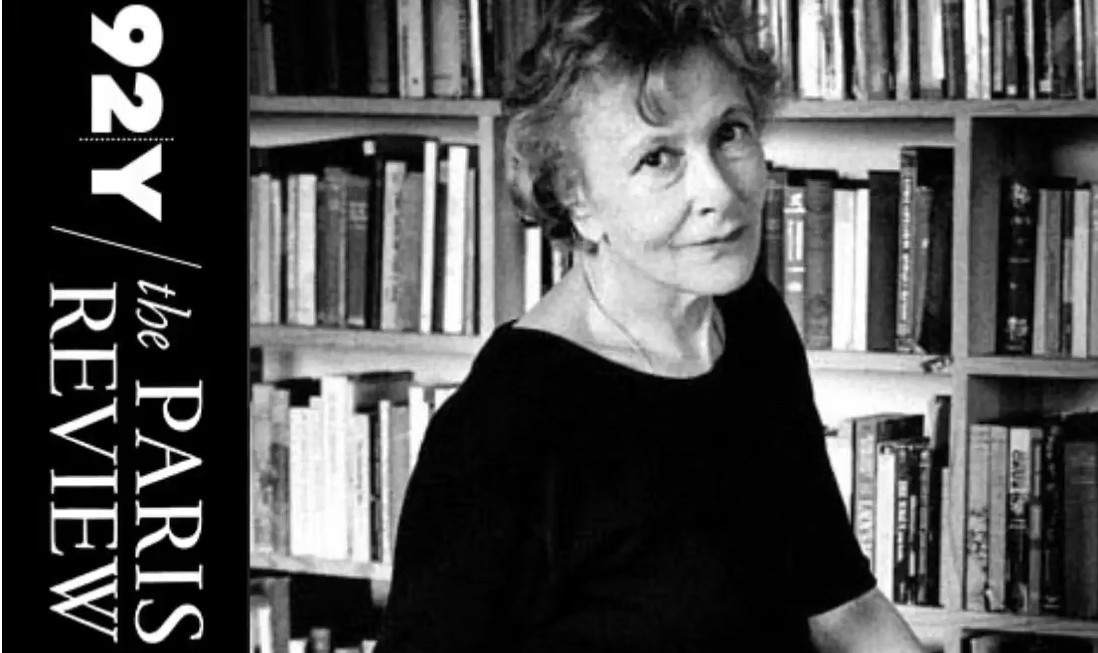
Poetry Center Denise Levertov 1991
*
Dr. Kolodney had confided in Williams that there was one elusive poet he had always wanted to bring to the Poetry Center: Archibald MacLeish. William took this as a challenge. But how could she find him?
Williams went to the New York Public Library and found one of MacLeish's poetry books. The flap of the book jacket stated that MacLeish was living in Upper Conway, New Hampshire.
"In that era, we had a simple system to request phone numbers. You dialed 4-1-1. So that's how I got MacLeish's phone number in New Hampshire. I got him on the phone, and I said, 'This is the 92nd Street Y Poetry Center, and we were wondering if you would be willing to come and read next year?' He said he'd love to! That was my first major coup at the Poetry Center. I remained there for the next 12 years."
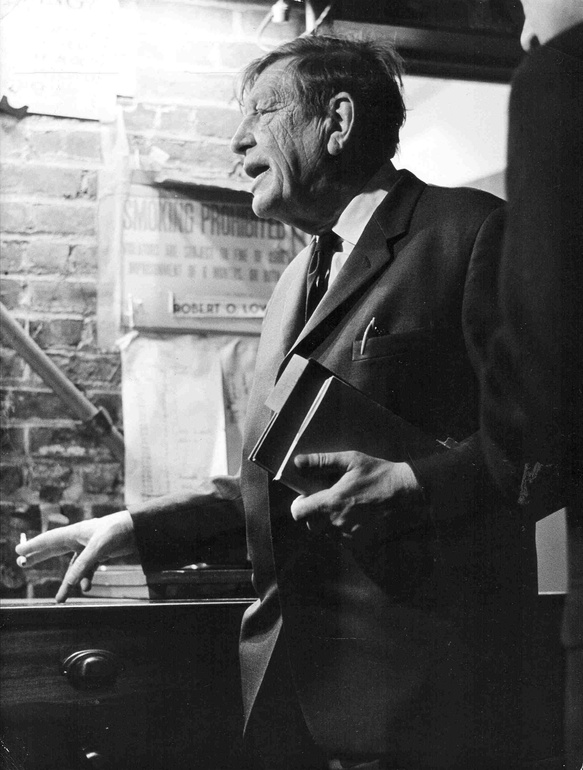
WH Auden at the Poetry Center 1970
*
Another one of her early coups was persuading W. H. Auden, who had once directed the Poetry Center, to return for a reading. Auden was famously prickly about appearances, but Williams had a gift for persuading big names to show up — partly because she offered them not just prestige but good pay and respect for their craft.
One of Williams's inspirations was Dylan Thomas, another former director of the Poetry Center. He died in 1953, long before her directorship, but the spirit of his lively, sold-out readings had helped form the Poetry Center's identity. Williams capitalized on that reputation, booking major poets whose readings drew crowds, such as Robert Lowell, John Ashbery, and Anne Sexton.
She understood that an electrifying reading could make poetry feel alive — not just words on a page but a performance that could fill a hall like a rock concert.
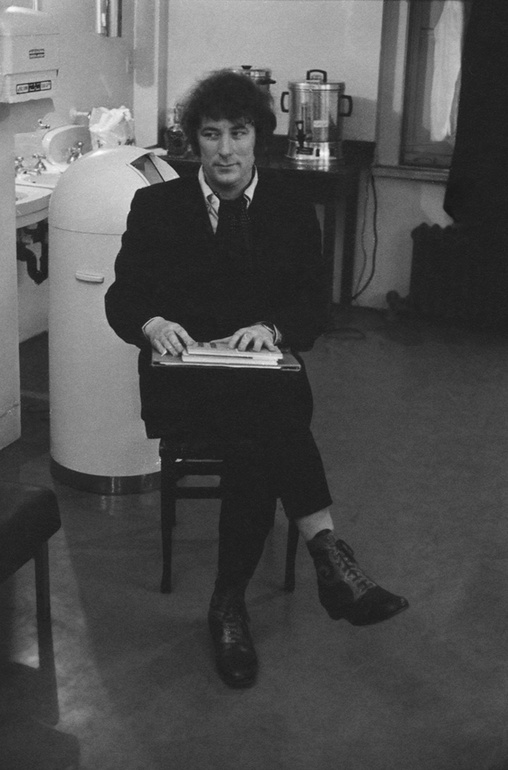
Seamus Heaney 1971
*
Williams became known for her quietly persuasive manner, her persistence, consistent successes in securing funding, and attracting top names to the Poetry Center. She recalled securing grants from the New York Arts Council to fund readings by major poets at New York State universities. "There was a tremendous void out there. If a university wanted to reach T.S. Eliot for an event on campus, they would call us. There was no other place for them to look."
At the height of the civil rights movement, the Poetry Center also secured funding from the New York Arts Council and the National Endowment for the Arts to install Black writers at universities and fund writers-in-residence programs, so it would not be a financial burden on the colleges.
"I went down to the south personally," Williams said. "I think there were nine Black colleges I visited. We had money from the National Endowment for the Arts to pay the writers."
Williams always offered a hand up for marginalized voices. She made sure funding didn't stay only in New York. She wanted rural libraries, community centers, and even prisons to host writers. For writers of color and working-class poets, this decentralized approach was revolutionary.
Early in the program's history, she argued with bureaucrats who didn't understand why a tiny public library in upstate New York or a community college in the Bronx deserved the same literary events as Manhattan's big halls. She won those fights — and dozens of now-famous writers got early gigs because of it.

Poetry Center, Denise Levertov 1991
*
The Poetry Project
In 1970, Dr. Kolodney turned 70 years old and faced mandatory retirement. He wanted to install his son as his replacement, and he asked Williams to train him. "It was blatant nepotism," she confided. "His son had no qualifications. But I couldn't say no." Williams graciously stayed on through the transition.
That work overlapped with her launching the Poetry Project. At the time, even at a renowned venue like the Y, writers were often paid modestly, if at all. Williams was determined to ensure readings paid fair fees, and she devised the Poetry Project to get public funding to pay poets to travel to libraries, schools, and community centers far beyond Manhattan's cultural elite. Poets would be paid directly.
Seeing its promise, she wanted to take it further than the Y's framework would allow. In 1970, with $30,000 in seed money from the New York State Council on the Arts, she formally spun off the project as Poets & Writers, Inc.
She initially ran Poets & Writers out of her New York City apartment, growing it into what would become the largest nonprofit literary service organization in the country.
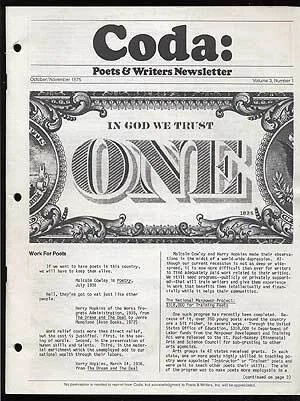
In its first decade, in addition to supporting and compensating writers through publication and literary events, Poets & Writers became a national clearinghouse of information. By 1973, it had compiled much of its knowledge into A Directory of American Poets and Fiction Writers, initially a photocopied and stapled publication that listed contact information for writers. Subsequently the Directory began to include literary news, advice to writers, and information on grants and awards. Gradually, this evolved into a 32-page newsletter, Coda, which in turn became the foundation for Poets & Writers Magazine, launched in 1987.
Throughout the 1980s and 1990s, Poets & Writers cultivated new revenue streams, enabling the organization to expand its programs and publications. Editorial and design changes elevated Poets & Writers Magazine to new subscription and advertising levels. The organization's Readings & Workshops program was offered in new regions across the country, connecting writers and audiences in California, Chicago, and Detroit, in addition to New York State, where the program began. And the Writers Exchange program, which would introduce emerging writers to the New York literary community, was initiated.
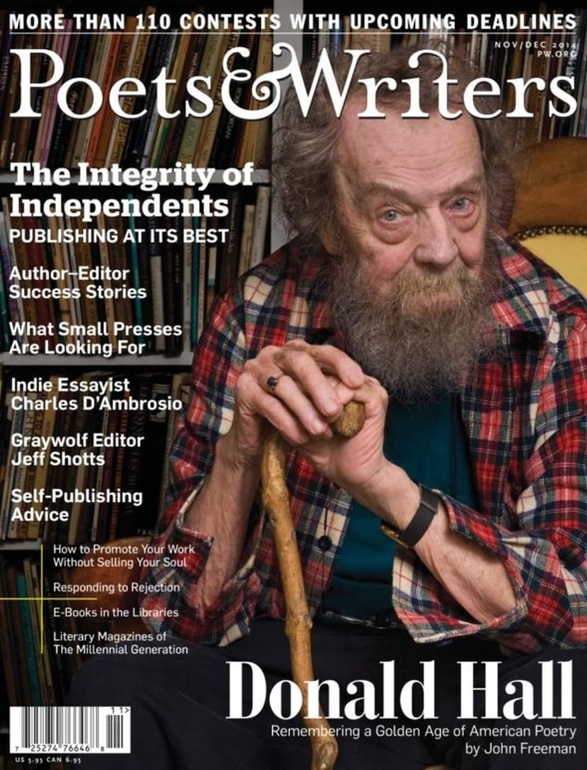
P&W cover, Donald Hall
*
The website was launched in 1996. Since then, www.pw.org has become a virtual resource center for thousands of writers, with up-to-date information on grants and awards, literary magazines, agents, presses, jobs, and literary events; an active message forum on topics of interest to writers, online-only content from Poets & Writers Magazine, and more.
In 2006, Poets & Writers successfully completed its first capital campaign, raising $3 million and establishing an endowment to bring the Readings & Workshops program to six new cities: Atlanta, Houston, New Orleans, Seattle, Tucson, and Washington, D.C. In 2007, P&W introduced the Jackson Poetry Prize, which each year awards $50,000 to a distinguished early to mid-career poet.
Although she never held the formal title of "Editor-in-Chief," Williams was the guiding editorial presence for Poets & Writers during its formative years, shaping both its vision and its practical mission to support writers. The magazine currently has more than 100,000 readers.
One of her favorite memories of her days at Poets & Writers was a 15th anniversary celebration at the Big Apple Circus in 1985. Williams and a few well-known writers entertained the crowd with circus acts. Norman Mailer did a balancing feat, and Erica Jong rode an elephant. And Williams? She did an impressive trapeze act.
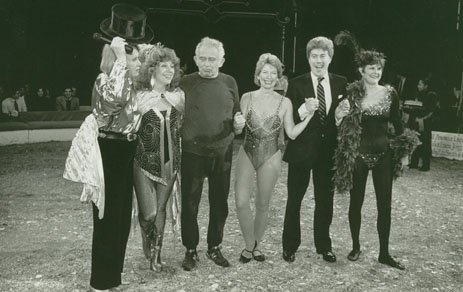
Norman Mailer, Erica Jong, Galen Williams, Big Apple Circus 1985
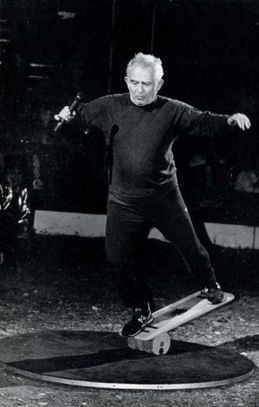
Norman Mailer, Big Apple Circus 1985
*
Meanwhile...
While establishing her career, Williams also saw momentous changes in her personal life. She had divorced her first husband in Tijuana, and met her second husband through her work with major publishers. William Rossa Cole was an editor at Simon & Schuster. He was also a poet, children's book writer, and poetry anthologist.
She married Cole in 1967. Using a small inheritance after her mother died, Williams bought a modest house in East Hampton, Long Island, where the couple raised their two sons: Williams and Rossa. In addition to her work at the Poetry Center, she also did landscaping work for clients on Long Island, having studied at the New York Botanical Gardens. As she put it, "I dug holes."
On a typical week, Williams took the Long Island Railroad to New York City on Tuesdays, using the train as her mobile office. She stayed two nights in the city and returned Thursday evening. Often on Thursday nights, she would go to a spa called Gurney's in Montauk, at the eastern tip of Long Island, at 9 or 10pm and swim laps in the saltwater pool. This grueling regimen was her way of reviving herself for the weekend, when she would focus on her landscaping work.
"It was exhausting. My husband was 20 years older, and men of his generation didn't push around baby carriages. But his daughter stayed with us, and she helped with the kids."
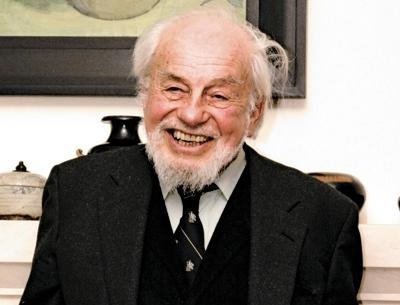
Harvey Shapiro
*
Harvey Shapiro
Williams crossed paths many times over the years with Harvey Shapiro, initially meeting him at Harvard. Shapiro was an American poet, an editor of the New York Times and contributor to The New Yorker. He wrote a dozen books of poetry from 1953 to 2006. He was continuously affiliated with the New York Times in some capacity, mainly in the magazine and book reviews, from 1957 to 2005. He was also the author of that scathing New York Times critique of the Poetry Center when it withheld the Bernstein Poetry Prize from Phil Seidel, leading to the resignations that propelled Williams' early career.
"Harvey was always around in some way. He had a summer place in the Hamptons. We would be at the same parties. And we moved in the same literary circles."
The two became close in the late 1990s after both were divorced, and they enjoyed a rich and lasting partnership for 15 years. Williams cared for Shapiro in his final days; he passed away in 2013, just a few weeks before his 89th birthday. In an interview that Williams conducted with Shapiro that was printed in Brooklyn Rail magazine in 2013, her son Williams Cole wrote the following in his preface:
|
|
|
|
"There's a photo taken at a literary party in the '70s where my mother's profile can be seen in a mirror next to where Harvey is standing. Bill Henderson, the founder of Pushcart Press, gave them the photo a few years ago and wrote on it, 'Remembrance of things to come.'
"Most important of all to me, is that he really loved my mother. I will never forget the particularly sharp guffaws he would emit as he listened to her converse in social situations. And as his health problems began to mount over the last decade or so, she cared for him ardently. I could see the gratefulness in his eyes that he wasn't alone. And I could see that the poet who so often wrote about the big questions of existence and death had found a reason to hang on for as long as he could."
| |
|
|
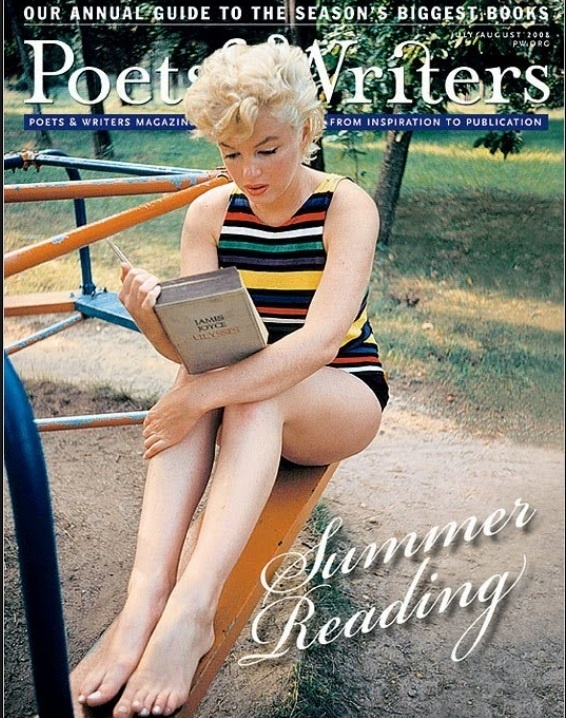
Poets & Writers cover, Marilyn Monroe
*
San Miguel
Williams first came to San Miguel de Allende in 2006 for a brief visit. In 2013, after Harvey Shapiro passed away, she began to visit annually, staying for a month with her friend Sheridan Sansegundo, long-time arts editor for the East Hampton Star. After back surgery in the States in 2019, she returned in 2020, and was forced to stay longer than expected because of Covid. She decided to make San Miguel her home, and she received her permanent visa this year.
When asked if she was a writer herself, Williams shrugged. "I know real writers. That isn't me. I always took classes, like The Writers Studio in New York, founded by poet Philip Schultz. But I'm not a writer."
She added, "I think my main success in life is that my two boys love and talk to each other all the time. And their wives love and talk to each other all the time. It's my greatest joy."
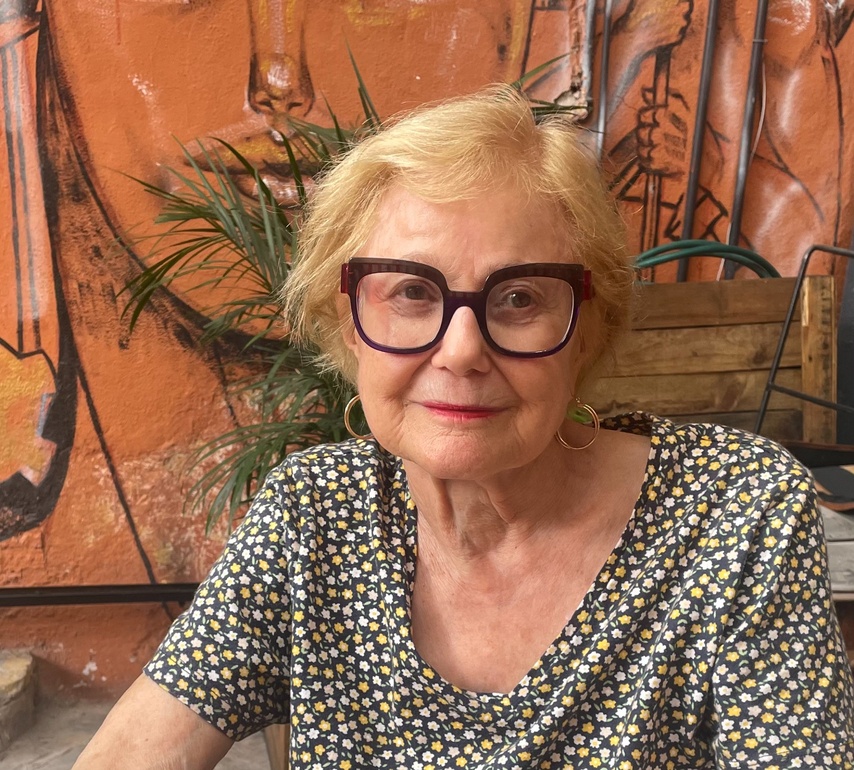
Galen Williams 2025
*
Her Legacy
In 2010, to mark the organization's 40th Anniversary, P&W launched a $1 million campaign to honor its founder Galen Williams and to fund ongoing initiatives. These included the Galen Williams Endowment, the Galen Williams Fellowship Program, and further investment in the website and other digital assets. The 40th Anniversary Fund also supported the development of Poets & Writers Live, a series of live events launched in 2013.
In 1990, E. L. Doctorow described Poets & Writers as "a saintly little service organization for writers across the country. It tells them where the jobs are, the reading gigs, the grants, the awards competitions, and it brings them news of each other. Not its least valuable service is the one that comes of all the others—the suggestion of community implicit in this lowliest and most dire of professions."
Today, Poets & Writers continues to provide encouragement, advice, community, and financial support to writers across the country. By the time she stepped down, paying writers for readings, workshops, and local residencies was no longer radical – it had become normal practice. She quietly helped thousands of writers pay the rent, travel, and keep going when publication alone wasn't enough.
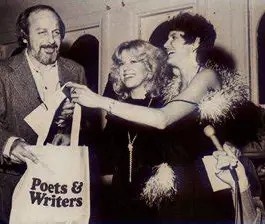
Poets & Writers 40 Year Anniversary
*
Many lesser-known poets in the 1970s and early 1980s, especially those outside big cities, got their first paid readings through Williams' Readings & Workshops program.
For example, Sharon Olds — now one of America's major poets — has spoken about how vital early grants and paid readings were. Though she rose to prominence through the Poetry Center, too, the "mini grants" from Poets & Writers gave her freedom to read and teach in places that wouldn't otherwise pay an honorarium.
Williams was famous for her index card files, her little box of opportunities, started in an old recipe box. She tracked every funded reading on these handwritten index cards. A poet might call her directly, saying, "I'm in Buffalo, is there a school that needs a poet visit?" She'd shuffle through her box and match the poet with a local contact.
People who worked with her recall this as "the original gig economy for poets" – with integrity and real fees, not exposure-only work.
Besides individual poets, Williams supported the ecosystem: under her leadership, Poets & Writers distributed grants to tiny literary magazines and new small presses. Many early issues of what became iconic journals — like Ploughshares or The Massachusetts Review — benefited from her push to funnel state arts money to literary projects rather than just big institutions.
Unlike big-name editors who took credit publicly, Williams didn't self-promote. Some early Poets & Writers board members described how she preferred the "infrastructure work" — building funding streams, writing proposals, making personal calls to cash-strapped poets — rather than being the face of the organization. One colleague remembered her spending evenings at her dining room table, drafting letters to arts councils, poet by poet, gig by gig.
Williams always instinctively understood the motto on her signet ring: Cognoscere occasionem.
**************

Catherine Marenghi is a local poet, novelist and memoirist who has been active in the San Miguel literary scene for more than a decade. She has published three poetry books, a memoir, and a historic novel. A native of Massachusetts, she has made San Miguel her permanent home.
www.marenghi.com
**************
*****
Please contribute to Lokkal,
SMA's online collective:
 ***
***
Discover Lokkal:
Watch the two-minute video below.
Then, just below that, scroll down SMA's Community Wall.
Mission

Visit SMA's Social Network
Contact / Contactar

|
|
|
|
| | |
Click ads
Contact / Contactar
 copyright 2026
copyright 2026
|
